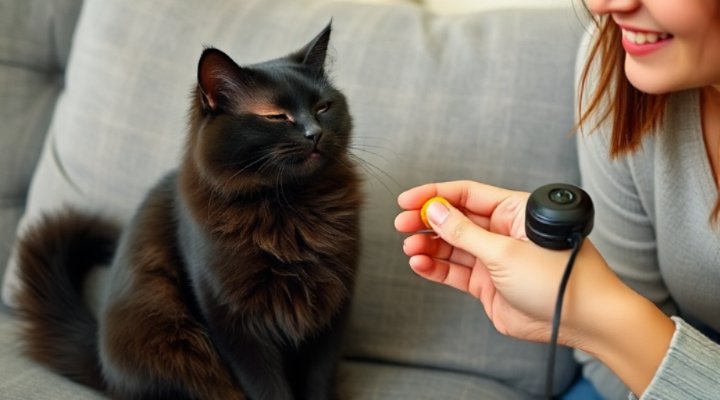Cat clicker training is a fantastic way to bond with your feline friend while teaching them new skills. Unlike dogs, cats are often seen as independent creatures, but with the right approach, they can learn just as much. In this guide, we’ll walk you through the basics and advanced techniques of cat clicker training, ensuring a fun and rewarding experience for both of you.

What Is Cat Clicker Training?
Clicker training is a form of positive reinforcement that uses a small device called a clicker to mark desired behaviors. The click sound is immediately followed by a treat, helping your cat associate the sound with a reward. Over time, this method can be used to teach everything from simple commands like ‘sit’ to more complex tricks like ‘high-five.’
For example, when I first started clicker training with my cat, Whiskers, I was amazed at how quickly she picked up on the concept. Within a few sessions, she was sitting on command and even learned to spin in a circle!

Getting Started with Clicker Training
Before you begin, you’ll need a few supplies: a clicker, small treats your cat loves, and a quiet space free from distractions. Start by ‘charging’ the clicker—click and give your cat a treat repeatedly until they associate the sound with the reward. This usually takes about 10-15 repetitions.
Once your cat understands the click means a treat is coming, you can start shaping behaviors. For instance, if you want to teach your cat to sit, wait for them to naturally sit, then click and treat. Gradually, they’ll learn to sit on command.
Meanwhile, if you’re also interested in dog training, check out our guide on Good Dog Training: How to Raise a Well-Behaved Pet Dog.

Advanced Clicker Training Techniques
Once your cat has mastered the basics, you can move on to more advanced tricks. For example, teaching your cat to high-five involves breaking the behavior into smaller steps. First, reward them for lifting a paw, then for touching your hand, and finally for a full high-five.
Above all, patience is key. Cats learn at their own pace, and pushing them too hard can lead to frustration. Keep sessions short (5-10 minutes) and always end on a positive note.
For more tips on training pets, visit the American Veterinary Medical Association.

Common Challenges and Solutions
Some cats may lose interest in training or become distracted. If this happens, try using higher-value treats or changing the training environment. Additionally, make sure your cat isn’t too full or tired during sessions.
In conclusion, cat clicker training is a rewarding way to engage with your pet and teach them new skills. With consistency and patience, you’ll be amazed at what your cat can learn.
Related Keywords: cat training, clicker training for cats, how to train a cat, cat tricks, positive reinforcement for cats
